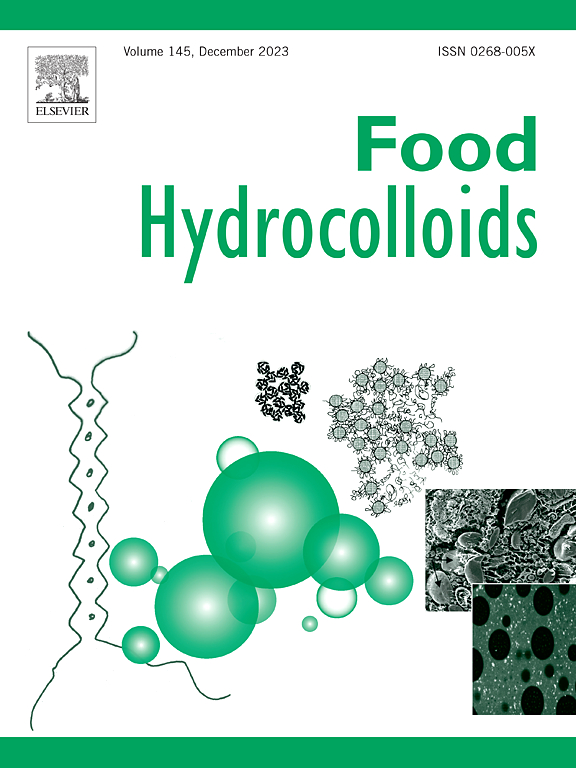Oil-based micro-sized extraction system designed from O/W Pickering emulsion template for highly efficient nanoplastics removal in the gastrointestinal tract
IF 11
1区 农林科学
Q1 CHEMISTRY, APPLIED
引用次数: 0
Abstract
The widespread presence of nano-sized plastic particles in the environment and foods, and their potential harmful effects on human health through intestinal absorption, have become an escalating global concern. Current methods and technologies have limited focus on the removal of nanoplastics (NPs) from the human body. In this work, highly bio-safe natural oil droplets, covered by the interworking natural regenerated apple nanofibers (ANFs), demonstrated high efficacy in removing NPs from the gastrointestinal tract. Pectin-containing ANFs with native dissociated carboxyl groups act as stabilizers to produce a clean-label oil-in-water Pickering emulsions (O/W PE) together with canola oil and water. Attributing to the internetwork of ANFs, oil droplets are protected from shedding, and unabsorbed ANFs fabricated entangled networks ensure the distribution and stability of O/W PE in simulated gastrointestinal fluids. Notably, the extraction efficiency of NPs reached up to 100 % and 98.69 % in the simulated gastric and intestinal fluids, respectively. Additionally, the highly efficient O/W PE showed superior capability in removing NPs adhered to the small intestine. This study represents the first attempt to remove NPs from the gastrointestinal tract, offering an attractive and promising strategy for eliminating NPs from the human body.

基于O/W Pickering乳剂模板设计的用于胃肠道中高效纳米塑料去除的油基微型萃取系统
环境和食品中广泛存在的纳米塑料颗粒及其通过肠道吸收对人类健康的潜在有害影响,已成为全球日益关注的问题。目前的方法和技术对纳米塑料从人体中去除的关注有限。在这项工作中,高度生物安全的天然油滴,被相互作用的天然再生苹果纳米纤维(ANFs)覆盖,在去除胃肠道NPs方面表现出很高的功效。含有天然解离羧基的果胶ANFs作为稳定剂与菜籽油和水一起生产清洁标签的水包油皮克林乳状液(O/W PE)。由于ANFs的相互作用,油滴不会脱落,而未被吸收的ANFs制造的纠缠网络确保了O/W PE在模拟胃肠道液体中的分布和稳定性。NPs在模拟胃液和模拟肠液中的提取效率分别达到100%和98.69%。此外,高效的O/W PE在去除粘附在小肠上的NPs方面表现出优异的能力。这项研究首次尝试从胃肠道中清除NPs,为从人体中清除NPs提供了一种有吸引力和有前途的策略。
本文章由计算机程序翻译,如有差异,请以英文原文为准。
求助全文
约1分钟内获得全文
求助全文
来源期刊

Food Hydrocolloids
工程技术-食品科技
CiteScore
19.90
自引率
14.00%
发文量
871
审稿时长
37 days
期刊介绍:
Food Hydrocolloids publishes original and innovative research focused on the characterization, functional properties, and applications of hydrocolloid materials used in food products. These hydrocolloids, defined as polysaccharides and proteins of commercial importance, are added to control aspects such as texture, stability, rheology, and sensory properties. The research's primary emphasis should be on the hydrocolloids themselves, with thorough descriptions of their source, nature, and physicochemical characteristics. Manuscripts are expected to clearly outline specific aims and objectives, include a fundamental discussion of research findings at the molecular level, and address the significance of the results. Studies on hydrocolloids in complex formulations should concentrate on their overall properties and mechanisms of action, while simple formulation development studies may not be considered for publication.
The main areas of interest are:
-Chemical and physicochemical characterisation
Thermal properties including glass transitions and conformational changes-
Rheological properties including viscosity, viscoelastic properties and gelation behaviour-
The influence on organoleptic properties-
Interfacial properties including stabilisation of dispersions, emulsions and foams-
Film forming properties with application to edible films and active packaging-
Encapsulation and controlled release of active compounds-
The influence on health including their role as dietary fibre-
Manipulation of hydrocolloid structure and functionality through chemical, biochemical and physical processes-
New hydrocolloids and hydrocolloid sources of commercial potential.
The Journal also publishes Review articles that provide an overview of the latest developments in topics of specific interest to researchers in this field of activity.
 求助内容:
求助内容: 应助结果提醒方式:
应助结果提醒方式:


